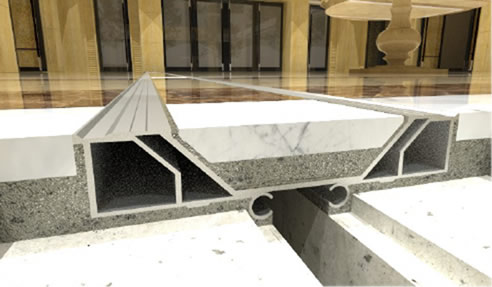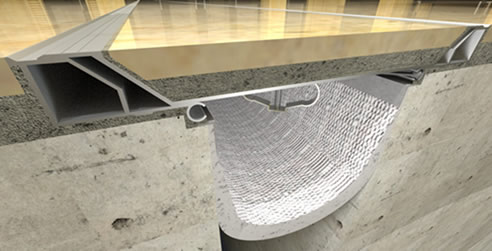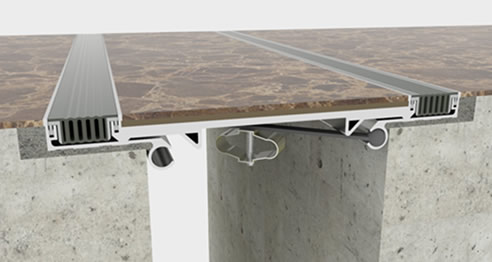Building Code Compliance with Unison Joints' Architectural Floor Seismic Joints

SeiMax G
When choosing joints, the difference between architectural floor seismic joints and mechanical floor expansion joint systems is significant. Expansion joint systems, mostly have single-phase movement... where the system opens and closes during normal thermal, shrinkage and wind movement. Seismic floor systems mostly have this same phase of movement; but they have another, seismic phase; which causes the cover (or 'pan') to rise up and over the surrounding floor finish during an earthquake. These systems are often quite large and therefore architecturally designed to hide their size. This is often in the form of housing the floor finish in a 'pan' shaped coverplate.
The design of architectural floor seismic joints is often complex. It demands undivided attention and clear focus from all designers and builders to ensure the proper sizing, sealing, safety, fire protection and provision of movement for all architectural floor seismic joints.
SeiMax Architectural Floor Seismic Joints from Unison Joints
With a service record of 17 years, Unison Joints remains the go-to company for architectural floor seismic joints, expansion joints and cover plate systems. The innovators in expansion and seismic joint designs, Unison manufactures and supplies high-quality systems throughout Australia and the Middle East.
The team of experts at Unison Joints has come up with an innovative design that addresses both functionality and aesthetics - the SeiMax G (Si G) seismic joints from Unison Joints' new SeiMax range!

SeiMax G (Si G)
SeiMax G (Si G) has a deep pan cover plate with a pan which houses thick floor finishes, such as terrazzo, granite, stone, paving, exposed concrete, tiles and other thick floor finishes. It is designed to adapt to multi-directional movements caused by a ground settlement or seismic activity.
In addition to ground settlement and earthquake, this type of seismic joints also relieves the stress and pressure produced by thermal movement. Compared to other floor seismic joints that use compressible seals, or caulking, SeiMax G (Si G) employs sliding-plates. This ensures less pressure on the system during normal or seismic movement.
SeiMax G (Si G) comes in an anodised alloy finish and is suitable to use in areas where decorative, durable and corrosion-resistant seismic joints are required like shopping malls, airport terminals and convention centres and other public and commercial structures.
SeiMax T (Si T)
SeiMax T (Si T) has similar specifications to SeiMax G (Si G). The only difference is that SeiMax T (Si T) has 2 caulked edges which divide the thermal movement in two. With its minimum visual impact and flushed-mounted system, the high-capacity SeiMax T (Si T) is ideal to use in commercial complexes and government buildings where there is light to heavy foot traffic. There is also a lower profile (Si TL) system which has a shallower pan for housing ceramic-tiles, carpet and other floor finishes.

SeiMax D (Si D)
The design of SeiMax D (Si D) combines the features of a recessed cover plate and thermoplastic seals. This type of seismic joints is compatible to use in tiles, vinyl, epoxy and exposed concrete.
SeiMax D (Si D) has a unique smooth ripple seal design to accommodate more movement compared to other flat-surface seals which can only stretch. The seals are made of dual-durometer Santoprene for areas where hygiene is a concern, such as hospitals and clinics. It can also be used in apartment buildings, museums, retail centres, airport terminals and other types of commercial buildings.

Talk to the experts at Unison Joints to learn more about the SeiMax architectural floor seismic joints. Call 1300 214 015 or head over www.unisonjoints.com.au today!

Please be advised that Unison Joints is unaffected by COVID-19 as our manufacturing products are not sourced from China.
|








 Flexible Waterproof Expansion Joint
Flexible Waterproof Expansion Joint Watertight Expansion Joint Gap Seal for
Watertight Expansion Joint Gap Seal for 100% Australian-Owned Materials for
100% Australian-Owned Materials for Unison Redefining Quality for Over 24
Unison Redefining Quality for Over 24 How to Select the Right Expansion Joint
How to Select the Right Expansion Joint Seismic and Fire-Rated Joint Systems for
Seismic and Fire-Rated Joint Systems for The New Sydney Fish Market Expansion
The New Sydney Fish Market Expansion Unison Joints at Oran Park Podium
Unison Joints at Oran Park Podium Fire-Rated Expansion Joint Systems for
Fire-Rated Expansion Joint Systems for Expansion Joint Cover for Concrete
Expansion Joint Cover for Concrete Carpark Expansion Joint Seal for
Carpark Expansion Joint Seal for EPDM Compression Seal for Carparks by
EPDM Compression Seal for Carparks by Cover Plate for Expansion Joints by
Cover Plate for Expansion Joints by Aluminium Floor Expansion Joint Covers
Aluminium Floor Expansion Joint Covers St Vincent's Hospital Upgrade Seismic
St Vincent's Hospital Upgrade Seismic Epoxy Grout for Nosing & Bedding of
Epoxy Grout for Nosing & Bedding of Slim Floor Coverplate with Hidden
Slim Floor Coverplate with Hidden Watertight Expansion Joint Solution from
Watertight Expansion Joint Solution from Epoxy Grout for Expansion Joint System
Epoxy Grout for Expansion Joint System Waterproof Expansion Joint Seals for
Waterproof Expansion Joint Seals for
